Composition
by Michael Frye | Mar 26, 2018 | Composition
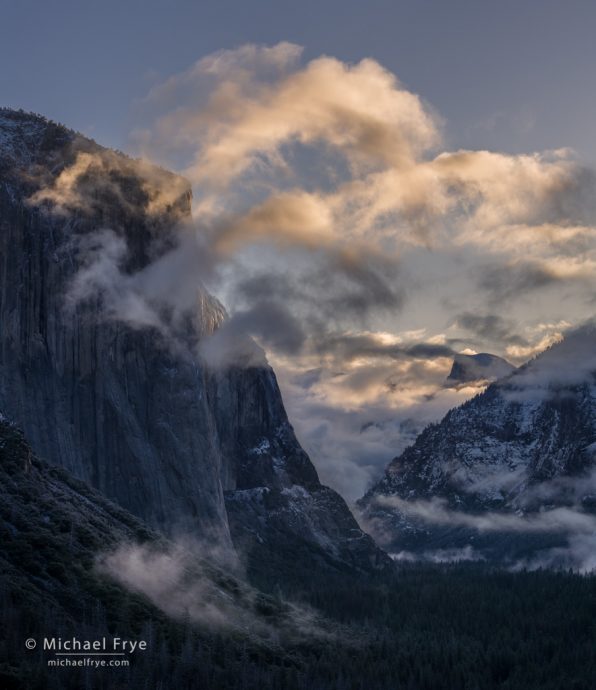
Clouds and mist from Tunnel View, Yosemite NP, CA, USA
We’ve had a series of storms recently. The last of these arrived Saturday and continued into the night. It wasn’t much of a storm; Yosemite Valley received only about three-tenths of an inch of water. But it was cold enough to leave a dusting of snow on the valley floor.
It looked like the storm would clear during the night, so I left for the valley around 11:00 p.m. Saturday, arriving just after midnight. But clouds and snow showers kept lingering so I ended up dozing in my car. I woke up around 5:30 a.m. and saw a few stars for the first time. At least the clearing seemed well-timed for sunrise.
(more…)
by Michael Frye | Mar 18, 2018 | Composition
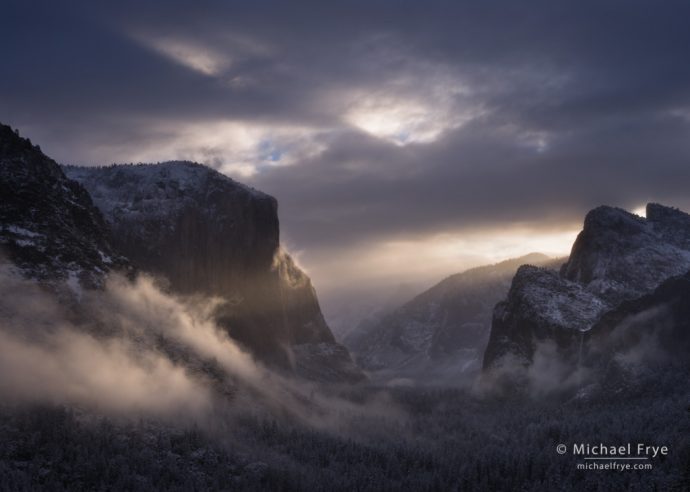
Sunbeams and morning mist from Tunnel View, Yosemite. While photographing this dramatic light from Tunnel View a few years ago, I zoomed out wide enough (to 40mm) to leave some dark areas between the bright clouds and the edges of the frame.
When you compose a photograph, you put a frame around a piece of the world, at a certain moment, and say, “Hey, look at this.” It’s the frame that creates the composition, and it’s the edges that define the frame. That’s why it’s so vital to pay attention to the edges of your photographs.
It’s always a good idea to run your eye around the edges of the viewfinder before pressing the shutter. Look for anything that might be distracting, and see if you can get rid of it. Look for objects that are cut in half along the edge, and decide whether you should include them or eliminate them.
(more…)
by Michael Frye | Mar 4, 2018 | Composition, Yosemite Photo Conditions
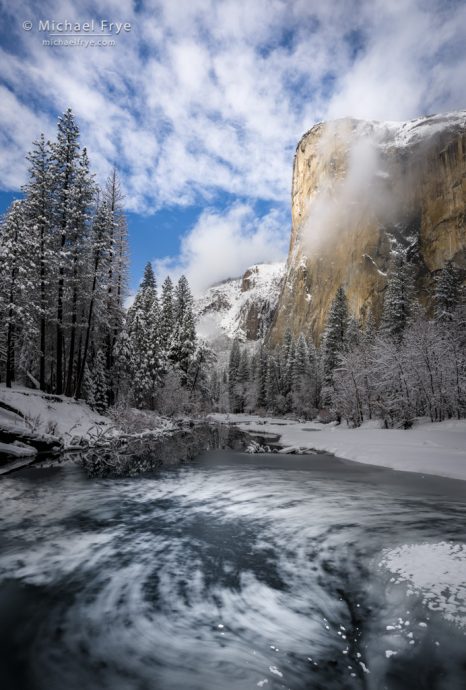
Winter morning, El Capitan and the Merced River, Yosemite NP, CA, USA
The big storm finally ended last night. Yosemite Valley received about four-and-a-half inches of liquid precipitation since Thursday. It started as snow, then changed to rain for awhile, and then changed back to snow, with about a foot of snow accumulating on the valley floor. Precipitation for this water year is still well below average, but this storm was a big help.
The forecast called for snow showers to continue all day Saturday and linger into the evening. But you never know, so I set my alarm for 4:00 a.m. on Saturday morning in case the storm started to break earlier than expected. After getting rudely awakened by the alarm I checked the radar and satellite images, which showed clear skies approaching from the west. But it didn’t look like they would reach Yosemite Valley until at least a couple of hours after sunrise. And besides, showers often linger in the mountains, and all the forecast predictions showed showers continuing in Yosemite all day. I went back to bed.
(more…)
by Michael Frye | Feb 25, 2018 | Composition
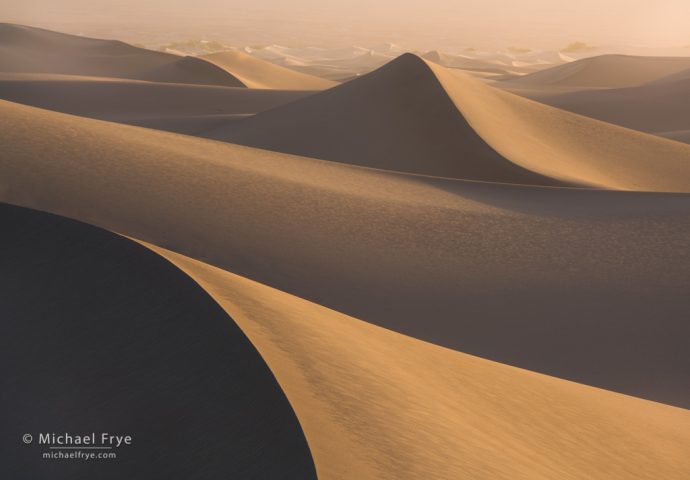
Sand waves, Mesquite Flat Dunes, Death Valley NP, CA, USA
Sand dunes are so much fun to photograph. They’re full of interesting lines, shapes, curves, and textures – almost as if they were sculpted for photographers. And they keep changing. Every big windstorm reshapes the dunes, creating new possibilities.
So when Claudia and I traveled to Death Valley last month to photograph the lunar eclipse, I had to make a couple of trips to the dunes during the day as well, just to fill my eyes and viewfinder with all that abstract beauty.
(more…)
by Michael Frye | Dec 17, 2017 | Composition
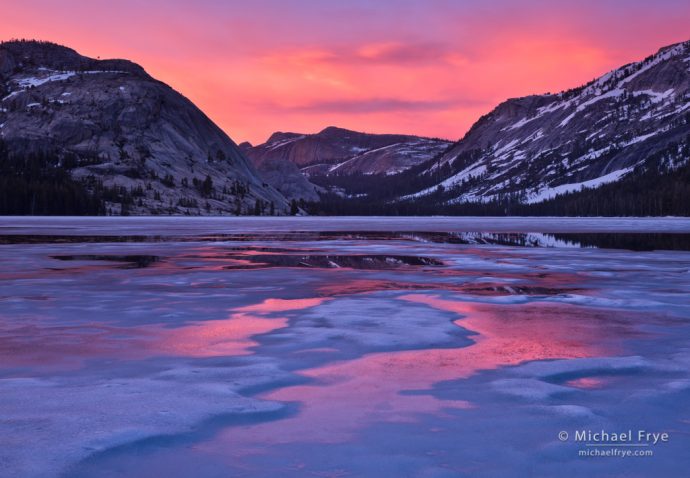
Sunset at Tenaya Lake, Yosemite. I had to work quickly to find a foreground design to go with this colorful sunset.
I’ve always been attracted to color. Color can be eye-catching, but more importantly to me, it’s a powerful tool for conveying a mood.
My attention is easily caught by colorful subjects like flowers, fall leaves, sunrise or sunset clouds, reflections, and so on. The colors don’t have to be bold; a subtle color palette can be just as compelling.
But while interesting colors always catch my eye, I know that color is not enough by itself. You can’t just point your camera toward something colorful and expect to make a great photograph. A frame filled with a random mishmash of autumn leaves won’t be compelling – it’ll just be a colorful mess. You need to find a design to go with that color. So I’m always looking for focal points and patterns that could help give structure to the color.
(more…)
by Michael Frye | Dec 10, 2017 | Composition
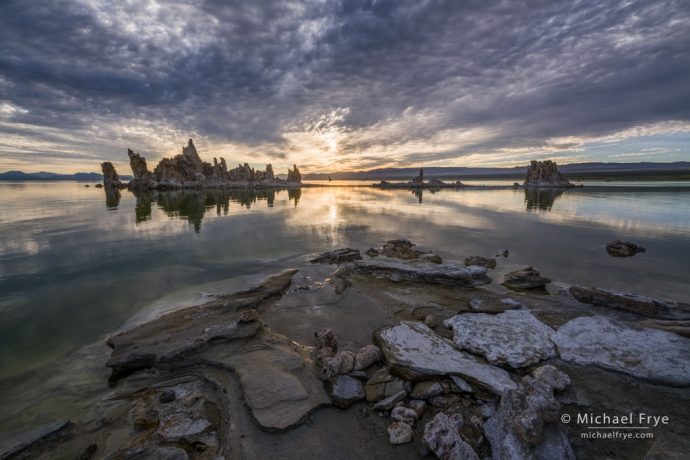
A: Morning light and clouds, Mono Lake. Can you guess what kind of lens I used for this photograph?
When I post a photograph, people often ask me which lens I used. I’m happy to tell them, but I don’t think you learn much when someone hands you an answer. I think it’s more instructive to try to guess yourself. Estimating what lens focal length a photographer used can help train your eye to see the world the way the camera sees, and learn how lenses control the sense of depth and perspective in a photograph. And those things will help you find compositions more readily, and make it easier to choose which lens to use in the field.
Wide-angle lenses often create a sense of depth, and immerse you into the landscape, while telephoto lenses flatten the perspective and isolate small parts of a scene. Telephotos are also great for creating patterns. Those traits aren’t always apparent, however, nor are they exclusive. You can show patterns with wide-angle lenses, and you can convey a sense of depth with telephoto lenses. And you can photograph intimate landscapes with wide-angle lenses, and show a vast, sweeping landscape with a telephoto.
(more…)














